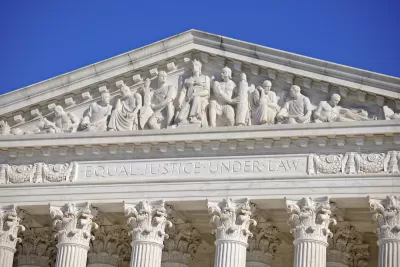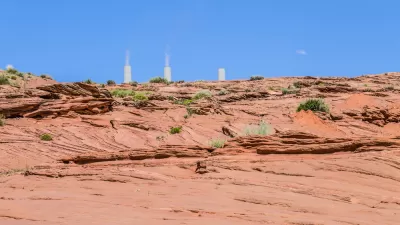A 1984 landmark Supreme Court ruling empowering federal agencies to interpret statutes when there is uncertainty is being challenged. The outcome will impact federal regulatory authority throughout government, particularly environmental protection.

Update:
“Chevron is overruled. Courts must exercise their independent judgment in deciding whether an agency has acted within its statutory authority,” Chief Justice John Roberts wrote for the majority.
A central part of any president’s strategy for reining in greenhouse gas emissions has a big problem in a post-Chevron Washington: The regulators draw their authority from a law that Congress hasn’t significantly updated in 34 years — well before most lawmakers were even thinking about the dangers of climate change.
A rather arcane case brought by Chevron USA against the National Resources Defense Council involving the Clean Air Act was decided by the U.S. Supreme Court in 1984, establishing the principle that “courts will give the [government] agency deference in ambiguous situations as long as its interpretation is reasonable,” according to Justia, a legal information website.
Chevron is likely the most frequently cited case in American administrative law and is the origin of the term “Chevron deference.”
That principle, long targeted by conservative groups, “lies at the heart of two cases the court heard this term: Loper Bright Enterprises v. Raimondo and Relentless v. Department of Commerce,” reports Andrew Welch for Barron's on June 27. “Both cases involve fishing boat operators who challenged the constitutionality of federal government regulations intended to protect Atlantic herring fisheries.”
During oral arguments in January, some conservative justices expressed skepticism about it, suggesting the court could overturn or curtail it.
Cataclysmic?
“Groups on both sides of the doctrine tend to talk about the case in cataclysmic terms because of the ways it could ripple through American law — changing the balance between those fighting government agencies, the agencies themselves and the courts overseeing the disputes,” reported Michael Macagnone for Roll Call on Jan. 26, 2024, the day before oral arguments were heard.
Macagnone wrote on May 1, 2023, after the Supreme Court agreed to review the case, that the outcome “could change the balance of power between executive agencies, Congress and the judiciary.”
“If the court decides to trim it back or fully overrule it, judges will be able to substitute their own interpretation of the law in more cases, and may be more likely to strike down existing agency rules,” reports Rachel Frazin, who covers energy and environment policy for The Hill, on June 25.
“[I]f the court gets rid of the doctrine, then we have a lot of questions about what kind of litigation will ensue, and I predict that a lot of particularly industry groups may bring challenges against environmental health and safety regulations that have been upheld under Chevron,” said Emily Hammond, [an expert in energy law, environmental law, and administrative law] at George Washington University.
The decision could come as early as Friday, June 28, or early next week.
A Planetizen news post last August, “Federal Fuel Economy Rules Take Different Path than Emission Standards,” referenced the Chevron deference principle, along with a 2022 landmark case involving federal regulations, W.Va. vs. EPA, which overturned the former President Obama's clean power plan rule.

Study: Maui’s Plan to Convert Vacation Rentals to Long-Term Housing Could Cause Nearly $1 Billion Economic Loss
The plan would reduce visitor accommodation by 25,% resulting in 1,900 jobs lost.

North Texas Transit Leaders Tout Benefits of TOD for Growing Region
At a summit focused on transit-oriented development, policymakers discussed how North Texas’ expanded light rail system can serve as a tool for economic growth.

Using Old Oil and Gas Wells for Green Energy Storage
Penn State researchers have found that repurposing abandoned oil and gas wells for geothermal-assisted compressed-air energy storage can boost efficiency, reduce environmental risks, and support clean energy and job transitions.

Private Donations Propel Early Restoration of Palisades Playground
Los Angeles has secured over $1.3 million in private funding to restore the Pacific Palisades playground months ahead of schedule, creating a modern, accessible space that supports community healing after recent wildfires.

From Blight to Benefit: Early Results From California’s Equitable Cleanup Program
The Equitable Community Revitalization Grant (ECRG) program is reshaping brownfield redevelopment by prioritizing projects in low-income and environmental justice communities, emphasizing equity, transparency, and community benefits.

Planting Relief: Tackling Las Vegas Heat One Tree at a Time
Nevada Plants, a Las Vegas-based nonprofit, is combating the city’s extreme urban heat by giving away trees to residents in underserved neighborhoods, promoting shade, sustainability, and community health.
Urban Design for Planners 1: Software Tools
This six-course series explores essential urban design concepts using open source software and equips planners with the tools they need to participate fully in the urban design process.
Planning for Universal Design
Learn the tools for implementing Universal Design in planning regulations.
Ascent Environmental
Borough of Carlisle
Institute for Housing and Urban Development Studies (IHS)
City of Grandview
Harvard GSD Executive Education
Toledo-Lucas County Plan Commissions
Salt Lake City
NYU Wagner Graduate School of Public Service






























